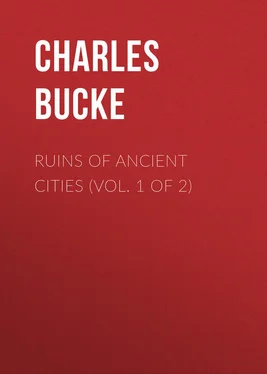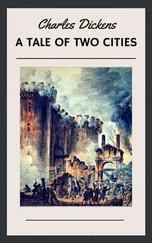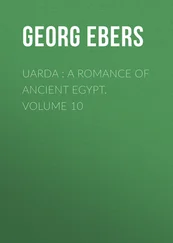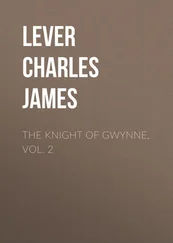Charles Bucke - Ruins of Ancient Cities (Vol. 1 of 2)
Здесь есть возможность читать онлайн «Charles Bucke - Ruins of Ancient Cities (Vol. 1 of 2)» — ознакомительный отрывок электронной книги совершенно бесплатно, а после прочтения отрывка купить полную версию. В некоторых случаях можно слушать аудио, скачать через торрент в формате fb2 и присутствует краткое содержание. Жанр: foreign_antique, foreign_prose, на английском языке. Описание произведения, (предисловие) а так же отзывы посетителей доступны на портале библиотеки ЛибКат.
- Название:Ruins of Ancient Cities (Vol. 1 of 2)
- Автор:
- Жанр:
- Год:неизвестен
- ISBN:нет данных
- Рейтинг книги:4 / 5. Голосов: 1
-
Избранное:Добавить в избранное
- Отзывы:
-
Ваша оценка:
- 80
- 1
- 2
- 3
- 4
- 5
Ruins of Ancient Cities (Vol. 1 of 2): краткое содержание, описание и аннотация
Предлагаем к чтению аннотацию, описание, краткое содержание или предисловие (зависит от того, что написал сам автор книги «Ruins of Ancient Cities (Vol. 1 of 2)»). Если вы не нашли необходимую информацию о книге — напишите в комментариях, мы постараемся отыскать её.
Ruins of Ancient Cities (Vol. 1 of 2) — читать онлайн ознакомительный отрывок
Ниже представлен текст книги, разбитый по страницам. Система сохранения места последней прочитанной страницы, позволяет с удобством читать онлайн бесплатно книгу «Ruins of Ancient Cities (Vol. 1 of 2)», без необходимости каждый раз заново искать на чём Вы остановились. Поставьте закладку, и сможете в любой момент перейти на страницу, на которой закончили чтение.
Интервал:
Закладка:
The Odeum of Regilla stands at the foot of the rock of the Acropolis. The remains of this edifice are those which Wheler and all former travellers, excepting Chandler, have described as the theatre of Bacchus 64 64 Clarke.
. Of the theatre of Bacchus , nothing remains except the circular sweep for the seats; as in the earliest ages of dramatic representation, it was universally formed by scooping the sloping side of a rock 65 65 The theatre of the ancients was divided into three principal parts; each of which had its peculiar appellation. The division for the actors was called in general the scene , or stage ; that for the spectators was particularly termed the theatre , which must have been of vast extent, as at Athens it was capable of containing above thirty thousand persons; and the orchestra , which, amongst the Greeks, was the place assigned for the pantomimes and dancers, though at Rome it was appropriated to the senators and vestal virgins. The theatre was of a semicircular form on one side, and square on the other. The space contained within the semicircle was allotted to the spectators, and had seats placed one above another to the top of the building. The square part, in the front of it, was the actors' division; and in the interval, between both, was the orchestra. The great theatres had three rows of porticoes, raised one upon another, which formed the body of the edifice, and at the same time three different stories for the seats. From the highest of those porticoes the women saw the representation, covered from the weather. The rest of the theatre was uncovered, and all the business of the stage was performed in the open air.
. The 66 66 Boindin; Rollin.
passion of the Athenians for the theatre is not conceivable. Their eyes, their ears, their imagination, their understanding, all shared in the satisfaction: nothing gave them so sensible a pleasure in dramatic performances, either tragic or comic, as the strokes which were aimed at the affairs of the public, whether some chance occasioned the application, or the address of the poets, who knew how to reconcile the most remote subjects with the transactions of the republic. They entered by this means into the interests of the people, took occasion to soothe their passions, authorise their pretensions, justify, and sometimes condemn their conduct, entertain them with agreeable hopes, instruct them in their duty in certain nice conjunctures; in effecting which they often not only acquired the applauses of the spectators, but credit and influence in the public affairs and councils: hence the theatre became so grateful, and so much the concern of the people 67 67 Plutarch, in his inquiry whether the Athenians were more eminent in the arts of war or in the arts of peace, severely censures their insatiable fondness for diversions. He asserts, that the money, idly thrown away upon the representation of the tragedies of Sophocles and Euripides alone, amounted to a much greater sum than had been expended in all their wars against the Persians, in defence of their liberty and common safety. That judicious philosopher and historian, to the eternal infamy of the Athenians, records a severe but sensible reflection of a Lacedæmonian, who happened to be present at these diversions. The generous Spartan, trained up in a state where public virtue still continued to be the object of public applause, could not behold the ridiculous assiduity of the Choragi, or magistrates who presided at the public shows, and the immense sums which they lavished in the decorations of a new tragedy, without indignation. He therefore frankly told the Athenians, that they were highly criminal in wasting so much time, and giving that serious attention to trifles, which ought to be dedicated to the affairs of the public. That it was still more criminal to throw away upon such baubles as the decorations of a theatre, that money which ought to be applied to the equipment of their fleet, or the support of their army. That diversions ought to be treated merely as diversions, and might serve to relax the mind at our idle hours, or when over a bottle; if any kind of utility could arise from such trifling pleasures. But to see the Athenians make the duty, they owed to their country, give way to their passion for the entertainments of the theatre, and to waste unprofitably that Footnote: time and money upon such frivolous diversions, which ought to be appropriated to the affairs and the necessities of the state, appeared to him to be the height of infatuation." – Montague.
.
The temple, dedicated to Augustus, consists of four Doric pillars of white marble, fluted, and, like those of all the other buildings of this order, without plinths or bases; they still support their architrave with the pontoon, on the top of which is a square piece of marble, seeming to have been placed there as the pedestal to some statue. There seems, also, to be some inscription on it, but by reason of the height, unintelligible. It is impossible to give a plan of the whole; the remains of it affording but little light towards discovering what form it was of.
Of the remains of the Stadium Panathenaicum, the most wonderful of all the works of Herodes Atticus: – "It has been usual to say of this," says Dr. Edward Clarke, "that nothing now remains of its former magnificence. To our eyes, every thing necessary to impress the mind with an accurate idea of the object itself, and of its grandeur, and of the prodigious nature of the work, seemed to exist, as if it had been in its perfect state. The marble covering of the seats, indeed, no longer appears; but the lines are visible of the different ranges; and perhaps a part of the covering itself might be brought to light by a removal of the soil."
This memorial of Attic splendour, and of the renown of a private citizen of Athens, became ultimately his funeral monument; and a very curious discovery may be reserved for future travellers in the majestic sepulchre of Herodes himself, who was here interred with the highest obsequies and most distinguished honours a grateful people could possibly bestow upon the tomb of a benefactor, who spared no expense for them while he was living, and every individual of whom participated in his bounty 68 68 He bequeathed to every Athenian a sum nearly equivalent to 3 l. of our money.
at his death 69 69 The funeral of Herodes Atticus must have afforded one of the most affecting solemnities of which history makes mention. He was seventy-six years old when he died; and in the instructions which he left for his interment, he desired to be buried at Marathon, where he was born; but the Athenians insisted upon possessing his remains; and they caused the youth of their city to bear him to the Stadium Panathenaicum, which he had built; all the people accompanying, and pouring forth lamentations as for a deceased parent. – Clarke.
.
Beneath the arch of Hadrian persons are conducted from the old city of Theseus to the new Athens, built by Hadrian. The stones are put together without cement; but the work is adorned with a row of Corinthian pilasters and columns, with bases supporting an upper tier in the same style of architecture. It was erected commemorative of Hadrian's return to Athens. A new city had arisen under his auspices. Magnificent temples, stately shrines, unsullied altars, awaited the benediction of this sacerdotal monarch; and it would, indeed, have been marvellous if the Athenians, naturally prone to adulation, neglected to bestow it on a benefactor so well disposed for its reception. The triumphal arch was of course prepared, and lasting characters thereon inscribed have proclaimed to succeeding ages, that "The Athens of Hadrian eclipsed the city of Theseus 70 70 Clarke.
."
Besides this arch, there are other remnants of structures erected in honour of Hadrian. Of these are the stupendous pillars which bear his name. In the time of Pausanias, there were one hundred and twenty pillars of Phrygian marble. Of these, sixteen columns of white marble, each six feet in diameter, and sixty feet in height, now remain; all of the Corinthian order, beautifully fluted, and of the most exquisite workmanship. "Certainly," says Wheler, "this was a work alone that may justify the liberality of Hadrian, and the great care he took to adorn the city; for this must needs have been a wonderful portico, both for beauty, use, and grandeur." Pausanias says, that it was enclosed with a cloister, in which were built rooms of the same stone, only the roofs of alabaster, gilded with gold, and the whole excellently adorned with statues and pictures. He founded also a library and a gymnasium.
Читать дальшеИнтервал:
Закладка:
Похожие книги на «Ruins of Ancient Cities (Vol. 1 of 2)»
Представляем Вашему вниманию похожие книги на «Ruins of Ancient Cities (Vol. 1 of 2)» списком для выбора. Мы отобрали схожую по названию и смыслу литературу в надежде предоставить читателям больше вариантов отыскать новые, интересные, ещё непрочитанные произведения.
Обсуждение, отзывы о книге «Ruins of Ancient Cities (Vol. 1 of 2)» и просто собственные мнения читателей. Оставьте ваши комментарии, напишите, что Вы думаете о произведении, его смысле или главных героях. Укажите что конкретно понравилось, а что нет, и почему Вы так считаете.












